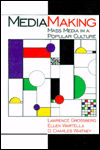
By Lawrence Grossberg, Ellen Wartella,
& D. Charles Whitney
Sage Publications, 1998
Reviewer: Krishna
Kandath
Ohio University
There is a plethora of books on mass media topics, in theory, research, and specific research traditions, among others. Many of these books are situated within the dominant paradigm of the discipline (the transmission model of communication; see http://www.stg.brown.edu/projects/hypertext/landow/post/poldiscourse/2views.html), a few adopt alternative paradigmatic perspectives or approaches to inquiry (such as the cultural model of communication; see http://www.wsu.edu:8001/vcwsu/commons/topics/culture/culture-definitions/raymond-williams.html; see also http://www.und.ac.za/und/ccms/articles/culture.htm). Nonetheless, given the complexities of living in media worlds, there is a tremendous demand for books written from alternative approaches or incorporating newer and different perspectives to enhance the understanding provided by research within the dominant tradition. Essentially, the complexity of living simultaneously in both media worlds and social worlds necessitates our effort to situate an understanding of mass media in a national culture such as the U.S., within broader and multiple frameworks of theory and research.
Given these challenges, my expectations were fulfilled by three individuals who have earned respect for their scholarship in the communication discipline. Grossberg, Wartella, and Whitney have authored an innovative and engaging book appropriately titled Mediamaking: Mass Media in a Popular Culture. In a sense, this book captures the complexities of meaning making in our saturated media worlds and how these meanings derive from contexts embedded in specific practices. In the first chapter, they profoundly forward: "Making . . . points to the fact that the world of human life is a world of practices. Practices are the various forms of human activity that transform some aspect of human reality" (p. 7; italics in original).
The chapters are organized under four sections. The first section "Placing the Media" comprised of chapters 1 through 4. These four chapters are focused on perspectives of communication study (transmission and cultural models), histories and transformations of human beings and media worlds, the individual and institutional involvement in the organization of mass mediated products, and finally, the political economy of mass communication respectively. While chapter 1 addressed the need for integrating research from both the dominant and cultural perspectives of communication, chapter 2 does a particularly good job of providing three historical narratives offering accounts of how communication and culture transform human history and vice versa.
Chapters 5 though 7 constitute the second section "Making Sense of the Media." Here, the authors provide a very thorough and engaging discussion of mediated social construction of reality, given our existence in media worlds. Chapter 5 offers a semiotic perspective of mass media's meaning making apparatus and chapter 6 focuses on making sense of media messages by breaking the codes and systems that give structure and function to the message. Chapter 7 is succinct and yet provides a thorough discussion of ideology, basically how we live and reproduce our everyday realities within the framework provided by mediated messages.
The third section encompasses chapters 8 through 11 under the heading "The Power of the Media." Chapter 8 is dedicated to mediated production of social identities, how we get know others and us as people in society, the focus being such issues as audience constructions and stereotyping. Chapter 9 is a brilliant discussion of the sociology of media consumption, how we use media to meet different kinds of needs in our daily lives. Chapters 10 and 11 are primarily focused on media effects research. The last section, "Media and Public Life" comprises chapters 12 through 15. Here, chapter 12 focuses on the role of news media in influence processes over such areas as politics. Chapter 13 is an engaging discussion of the public, an important concept in mass media research. Chapter 14 situates the theories used to examine media systems in terms of politics, economics, and sociology, among others. The concluding chapter of the book looks into mass media within the context of increasing globalization processes.
This is the kind of book that will meet the needs of students in undergraduate classes and foundation level graduate classes. My only regret with such a well-written book is that there are limitations in its global focus. Probably, the next edition may be more globally focused. I strongly recommend the use of this book for classes interested in examining the dynamics of living in media saturated worlds, whether they are in communications, sociology, or political science, among others.